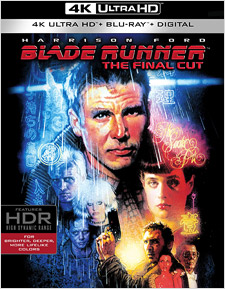Blade Runner: The Final Cut (4K UHD Review)

Director
Ridley ScottRelease Date(s)
1982/2007 (September 5, 2017)Studio(s)
The Ladd Company/The Blade Runner Partnership (Warner Bros.)- Film/Program Grade: A+
- Video Grade: A+
- Audio Grade: A+
- Extras Grade: B-
Review
In memory of Paul Prischman
[Editor’s Note: Portions of this review are excerpted from my longer review of the original Blade Runner: The Final Cut Blu-ray release from 2007 – you can read that here. Note that the Final Cut images below are photographs of the new 4K UHD presentation, projected with HDR. Don’t use them to judge color; it’s incredibly difficult to get color to reproduce accurately via a cellphone camera.]
It’s easy to understate Blade Runner’s impact on the films that followed it, particularly in the genre of science fiction. Based on an eclectic and complex novel by Philip K. Dick (Do Androids Dream of Electric Sheep?), Blade Runner is as much a hard-boiled film noir detective story as it is science fiction. And yet on the latter score, the film’s high-concept premise ranks easily alongside such cinematic landmarks of the genre as Stanley Kubrick’s 2001 and Forbidden Planet. All you need to do is watch almost any of the classic works of Japanese anime (Akira, Ghost in the Shell, Patlabor) and you’ll see Blade Runner’s influence in nearly every frame.
Set in a gritty, run-down Los Angeles of the near future, Blade Runner follows the efforts of a somewhat reluctant police detective named Deckard (played by a young Harrison Ford, who was just coming into his own as an actor, fresh off the experience of making The Empire Strikes Back and Raiders of the Lost Ark). Deckard’s job is to “retire” (read: kill) rogue, synthetic humans called Replicants. These Replicants are made to do Humanity’s dirty work, acting as soldiers, laborers, and sex servants, and they’re given implanted human emotions and memories to make them seem more realistic. But those emotions eventually become troublesome as, over time, the Replicants develop real consciousness and identities of their own. For this reason, they’re also given four-year life spans, at the end of which they simply deactivate. But when they become aware of their own mortality, some Replicants grow desperate, choosing to run and hide in the shadows of society, in the vain hope of saving themselves... or at least understanding the meaning of their brief existence. When they run, it’s Deckard’s job to find and destroy them before they hurt the humans around them.

In addition to Ford’s steady on-screen presence, Blade Runner features seminal performances by the likes of Rutger Hauer, Edward James Olmos, Sean Young, and Daryl Hannah, not to mention a host of fantastic character actors. The film’s production design was overseen by legendary futurist Syd Mead, giving it a highly unique visual style never-before-seen on the big screen. The film also includes a sparse but evocative score by composer Vangelis (more commercially known for his work on Chariots of Fire). But it’s the efforts of director Ridley Scott for which this film is perhaps best known.
If The Duellists was the film that first garnered Scott critical notice, and it was Alien that brought him to the attention of a much wider audience, Blade Runner is the film that solidified his acclaim among hard-core cinephiles and earned him a loyal legion of fans. Scott’s near manic attention to detail and his use of rich, stylish, and atmospheric staging and camera setups are on full, unrestrained display here – a fact that caused significant problems with his producers and the studio at the time. Surprisingly, when the film was released into theaters, it was a critical and commercial bomb. Many people just didn’t know what to make of it. Over the years, however, opinions have shifted dramatically. Blade Runner is, today, considered one of the best films (if not the best) in Scott’s decidedly impressive body of work. It showcases Ridley at his most... well, Ridley. Even at the time of its original release back in 1982, Blade Runner quickly and definitively set its director apart from other filmmakers as a singular, visionary talent.
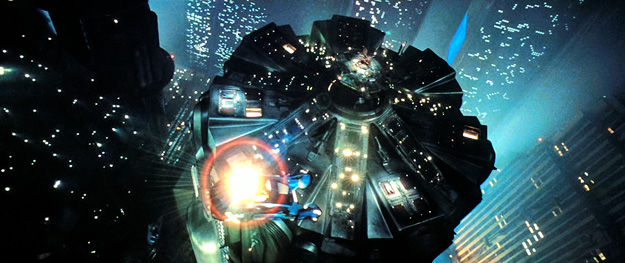
In the years since Blade Runner first dazzled and puzzled audiences around the world, a number of different versions of the film have surfaced. There’s the original theatrical cut, the international cut, the much sought-after (and seldom seen) “workprint,” and a 1992 director’s cut that wasn’t actually a director’s cut. Finally, in 2007 and some 25 years after the film’s debut, fans of Blade Runner finally had the chance to see it as its director intended.
An incredible wealth of vintage production material was unearthed from the vaults for that release, including some 977 cans of original film negative. Much of this footage was scanned at 4K resolution (some of the 65mm effects footage was even scanned at 8K) and an extensive restoration was done. Throughout this process, restoration producer Charles de Lauzirika worked closely with Warner Bros. and Ridley Scott to assemble the director’s ultimate version of the film, billed as The Final Cut. The running time is 117 minutes – virtually identical to the original theatrical release, but there have been many changes, most of them quite subtle. First, the film has undergone a painstaking frame-by-frame digital clean-up to remove unwanted dust, scratches and other age-related image defects. The film has been color-timed to Scott’s specifications, and its soundtrack has been remastered as well to take advantage of lossless audio (so when those Spinners fly by now, you’ll really hear them zoom past you and away).
As you’d expect, the film’s editing has been massaged here and there, but this time to Scott’s exact instructions. Like the 1992 version, this new Final Cut omits the Deckard narration and the happy ending. Scott has made subtle trims here and there to tighten the footage (without the narration, he felt that some shots went on a little too long), but he’s also added material. For example, the “unicorn” scene is now a bit longer and more effective (it’s actually the originally-intended version, the complete footage for which couldn’t be found for use in the ‘92 cut). Footage from both the international and workprint versions has been inserted into the film as well, including a number of street/atmosphere shots (such as the infamous hockey-masked geisha dancers) and more intense moments of violence.
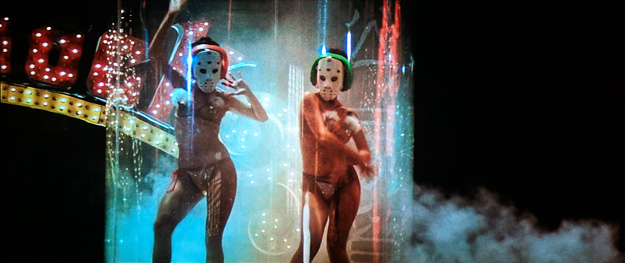
Scores of subtle digital tweaks have also been made to correct problems that couldn’t be addressed during the original production. For example, the wires supporting the practical, on-set Spinner vehicles have been removed. In a couple of street shots, members of the production crew accidentally appeared in the edges of the frame – they’re gone now. Various matte lines have been erased, and detail that was lost due to image degradation has been restored. When you see the infamous “eye” shot at the beginning of the film, the optical printing process employed at the time wouldn’t allow for a moving image of the eye to be used. So now, in The Final Cut, you’ll notice the pupil iris slightly in reaction to the plume of fire billowing before it.
Other digital corrections fix continuity errors. In the original shooting script, Leon and Deckard fought in the street before Zhora was “retired,” so the make-up reflected this on set. When the film was edited together, however, Leon and Deckard’s fight was moved after Zhora’s death. But the bruise on Deckard’s face was still there, before the fight actually happened on screen, so it’s been erased digitally. In another instance, the first time you see Roy Batty on screen in the sidewalk Vid-Phon booth, the shots were actually stolen from later in the film (a moment of Roy at the Tyrell Corporation, I believe, and a shot of him in the Bradbury building). So the lighting and the backgrounds you saw in those shots didn’t match the booth or the rain-soaked streets behind it. Now they do. There’s also a scene where Deckard is talking to an old Asian woman about the snake scale he’s found. She’s reading a serial number from a microscope... but when you saw that serial number on the screen, it didn’t match. Now it does. The vast majority of these digital effects tweaks are so subtle that only fans who are intimately familiar with the film will even notice them.
On the other hand, a few of the digital fixes correct more serious problems with the film in its previous incarnations. For example, when Roy releases the dove at the end of the film, the skyline revealed as it flies away just didn’t match anything you’d seen before. So a new digital cityscape was created for the shot that finally does match.

There’s also a scene when Deckard is talking to the snake dealer, Abdul Ben-Hassan, in which his lip movements didn’t match the dialogue. Harrison Ford was unavailable due to scheduling issues, so his son Ben was brought in correct this. Ben was shot on an effects stage from exactly the same angle, wearing exactly the same chin scar (via make-up) that his father has, saying the correct lines. His mouth was digitally inserted over his father’s seamlessly.
Of course, many of you know of the infamous reshoot from earlier this year, featuring the character Zhora. When news of this leaked on the Net, it sparked an outcry from fans who feared that Scott was drastically altering the film with all new scenes. It turns out, nothing could be further from the truth. Back in 1982, actress Joanna Cassidy wasn’t allowed to do the stunt where Zhora crashes through the window panes. But if you watch the film closely, especially now in high-definition, it’s painfully obvious that it’s a stuntwoman in those shots. So Cassidy was brought back in, dressed in her original costume, and was shot on a greenscreen stage, going through the same movements as the stuntwoman. Her face and body angles were matched to those of the stuntwoman’s frame by frame. Cassidy’s head was then digitally inserted over the stuntwoman’s, and the resulting image was blended, color-corrected and matched seamlessly. So now, when you see Zhora crash through the glass, it’s actually Zhora all the way through. The result is amazing. The first time I saw the finished sequence several months ago, I was actively looking for the effect and I completely missed it. It’s only when you re-watch the original scene on DVD that you appreciate how startling the difference is... and just how good the new effects shots actually are.
Here’s a comparison: This is how the Zhora sequence appeared in the original version of the film (from the 2007 Blu-ray)…
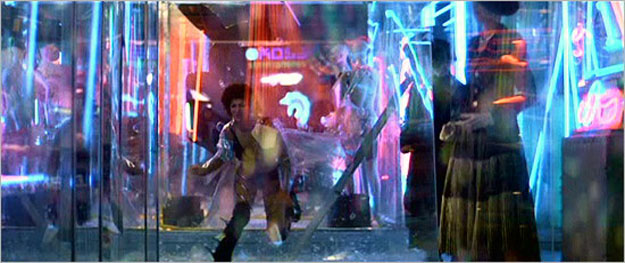
Now, here’s the new digital effects shot from The Final Cut (as seen in 4K Ultra HD)…

Ultimately, when you see The Final Cut for yourself, I think you’ll appreciate the tremendous and pain-staking effort that’s been made to smooth out the rough edges in Ridley Scott’s original film. I’ll tell you, I find it extraordinary after all these years to still have the chance to discover so much that’s new in this film. If you love Blade Runner like I do, this new version is a treat.
As indicated above, Blade Runner was shot on 35mm (and 65mm for select VFX footage) using anamorphic lenses and finished at the 2.39:1 theatrical aspect ratio. To complete The Final Cut in 2007, the negative was scanned at 4K resolution (8K for the 65mm) and finished as a full 4K Digital Intermediate. This has been given a new High Dynamic Range color grade (HDR-10) and is now available on the 4K Ultra HD Blu-ray format. The result is simply spectacular. The increase in fine detail visible here, even given the use of anamorphic lenses, leaves no doubt whatsoever that this is full 4K. You see it in things like the texture of skin and pores on faces, the collar of Deckard’s jacket, the finish on the “Ennis House” tiles on the walls of his apartment, the backlit shimmer of Pris’ hair and the reflective material in her coat, the different fabrics of Rachel’s blouse, the sticker on the windscreen of Gaff’s Spinner, the wash of rust or paint on the side of the Tyrell Corporation building, the pictures on the sides of Bryant’s lamp shade, hell… even the lettering on Deckard’s apartment keycard, which you can now read briefly in one shot. Grain is ever-present but never excessive; it’s just right to retain the look of a proper photochemical film production. And – oh, my god – the HDR! The film’s colors are incredible – more rich and vibrant looking than ever, but always accurate. Neon glows brightly, reflections shimmer, the Spinner Police lights flash and gleam. Scott and DP Jordan Cronenweth employed copious atmospherics in their framing and staging, and the HDR enhances those such a way that a wonderful sense of depth is added to the image here. The foreground shadows are ink black, while the backlit fog and mist in the background is more luminous. In between, highlights pick out details you’ve never noticed before. Look at the depth on Roy Batty’s face as he talks about glittering C-beams near the Tanhauser Gate, the details of his face sculpted in different colored reflections. I’ve seen this film quite literally hundreds of times. I’ve never seen it looking this good before. For a cinema classic, shot on film, this 4K Ultra HD presentation is a genuine stunner.
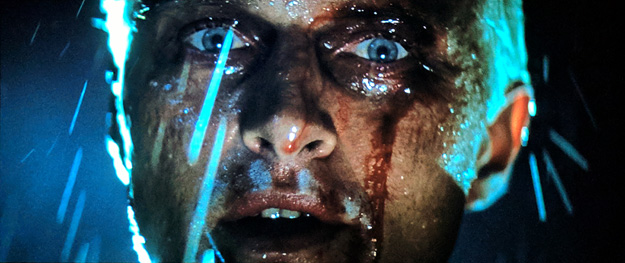
Audio-wise, the 4K Ultra HD includes a new object-based English Dolby Atmos mix that’s 7.1 Dolby TrueHD compatible. Like the TrueHD mix that was created for the previous 2007 Blu-ray release, this is a stunning audio presentation, featuring a big, wide soundstage, tremendous surround atmospherics, smooth channel-to-channel movement, crystal clear dialogue, and full LFE. Panning is a little more precise now and the height channels are actively engaged for music and atmospheric sound cues – overflying Spinners, advertising blimps, the patter of rain, etc – to complete the soundfield overhead for greater immersion. The improvement over the TrueHD is minimal, but no matter; the mix is a perfect match to the visuals in every way. Note that additional audio mixes include 5.1 Dolby Digital in French, German, Italian, Latin Spanish, Castilian Spanish, Portuguese, Czech, Polish Voice-over, and Russian. Optional subtitles are available English (for the Deaf and Hard of Hearing), French, German for the hard of hearing, Italian for the hard of hearing, Castilian Spanish, Dutch, three different forms of Chinese, Korean, Latin Spanish, Brazilian Portuguese, Arabic, Czech, Danish, Finnish, Hebrew, Norwegian, Polish, Portuguese, Russian, Swedish, and Turkish.
In terms of bonus features, the good news is that the actual 4K Ultra HD disc includes all three of the previous audio commentary tracks. The first features director Ridley Scott himself, the second features co-screenwriters Hampton Fancher and David Peoples, along with producer Michael Deeley and production executive Katherine Haber, and the third features futurist Syd Mead, production designer Lawrence G. Paull, art director David L. Snyder, and special effects supervisors Douglas Trumbull, Richard Yuricich and David Dryer. All three tracks are fine listens for different reasons. My favorite is the writers, who bust each other’s balls the entire time they’re discussing the film’s ideas and concepts, often forgetting who wrote what. They’re a real hoot to listen to. Note that the 4K disc also includes the Blade Runner: The Final Cut trailer in full 4K.
There are three additional discs in the packaging. You get a standard Blu-ray featuring The Final Cut in 1080p HD with the same commentaries – this is essentially Disc One of the 2007 Ultimate Edition. You also get another Blu-ray that features the Archival Versions of the film, including the U.S. Theatrical Cut (1982), the International Cut (1982), and the Director’s Cut (1992) all in 1080p HD – this is essentially Disc Three of the 2007 Ultimate Edition. But here’s the bad news: The final disc is a DVD only that includes – you guessed it – Charles de Lauzirika’s outstanding Dangerous Days: Making Blade Runner documentary in SD. That’s extremely disappointing, because I happen to know first-hand that this documentary was produced in full HD, so it could (and should) certainly have been included here in HD on a Blu-ray Disc. The fact that it’s not here means one of two things: The powers that be at Warner Bros. Home Entertainment either didn’t know that it was available in HD, or they knew and chose not to include it anyway. Either way, it’s such an oversight that I almost think the studio should correct it immediately – author a proper Blu-ray Disc of this documentary in full HD and send it out to those who purchase this set as a replacement disc. If the documentary had been upgraded to full HD, this 4K Ultra HD release would be an automatic must-have not just for 4K fans, but for every single fan of this film period. Alas, also not included here are the Enhancement Archive or Workprint BD discs from the 2007 release. Not that any of you were simply going to exchange this 4K release for the previous edition, but it would have been nice if all the previous HD bonus content had been included. For more on all of that, check my review of the 2007 edition here. You do at least get a paper insert in the package with a code for a Digital HD copy of the film. Nevertheless, the omission of previous extras and the lack of an HD documentary upgrade means I’ve had to knock my Extras grade down quite a bit compared to the 2007 BD release.
Blade Runner: The Final Cut is a breathtaking experience – truly the ultimate version of a classic film. It offers one of the most fully-realized fictional worlds you’ll ever seen on screen, and its vision is even more relevant today than it was back in 1982. The 2007 Blu-ray release deserved an honored place on the video shelves of every self-respecting cinephile. This new 4K Ultra HD release does as well, though the lack of Dangerous Days in true HD is a huge missed opportunity. Still, this in no way diminishes my enthusiasm for the A/V upgrade of the film itself in true native 4K with High Dynamic Range and Dolby Atmos. I’ve already watched it through twice today and I’m about to start on my third viewing; the moment it starts playing in 4K you just get completely lost in the image. Thirty years ago, I was proud to own Criterion’s laserdisc release of Blade Runner in standard definition. Now, I simply can’t imagine that this film will ever look or sound better than it does here. The 4K Ultra HD release is very highly recommended for diehard fans of this film and the 4K UHD format alike.
- Bill Hunt
(You can follow Bill on social media at these links: Twitter and Facebook)

